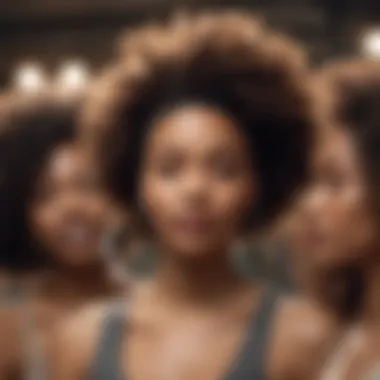Mastering Natural Hair Twisting Techniques and Benefits


Intro
Natural hair twisting is not merely a hairstyle; it is a rich expression of individuality and cultural heritage. This guide aims to delve into the art of twisting natural hair while offering practical insights to women of all ages. With the growing popularity of natural haircare, understanding the nuances of hair twisting has become increasingly vital. This section serves as a launching point into the concepts, techniques, and societal implications surrounding this expressive hairstyle.
The journey of embracing natural hair often involves exploration and self-discovery. Twisting has roots in various cultures and has transitioned from a traditional practice to a modern fashion statement. This guide will reveal the various aspects of natural hair twisting, highlighting its significance as a medium for self-care and personal expression. With insightful content throughout this article, readers will gain the knowledge to navigate their unique hair journey effectively.
Understanding Natural Hair Twisting
Natural hair twisting is more than just a styling technique; it is an art form that celebrates the beauty and versatility of natural hair. This section delves into the significance of understanding natural hair twisting, focusing on its benefits and considerations that come with this practice.
Defining Natural Hair Twisting
Natural hair twisting involves the manipulation of hair into spirals or coils, resulting in defined curls or waves. This technique can be achieved using various methods, including two-strand twists, three-strand twists, flat twists, and Bantu knots. Each method offers unique results and serves different purposes, such as protective styling or aesthetic preference. Understanding the differences between these techniques is essential for anyone looking to embrace their natural texture.
Historical Context and Cultural Significance
The practice of twisting natural hair has roots in various cultures across the globe. Historically, twisting has held cultural significance among African communities, symbolizing identity, heritage, and social status. It was not simply a matter of styling but a way to express self-worth and communal belonging. The evolution of this practice reflects broader trends in society's perceptions of beauty and individuality. Today, twisting continues to serve as a statement of pride among those who embrace natural hair, reaffirming its importance in contemporary culture.
The Science Behind Natural Hair Structure
To appreciate natural hair twisting fully, an understanding of hair structure is necessary. Natural hair is primarily composed of a protein called keratin, and its shape is influenced by genetics and the arrangement of the hair follicle itself. Curly hair tends to have an oval shape, causing it to bend rather than lie flat. This unique structure allows for various styling options but also requires special considerations for care. Moisture retention is crucial for maintaining health, as twisted styles can sometimes lead to dryness if not cared for properly. Therefore, employing the right products and methods is essential for optimal hair health.
"Embracing natural hair twisting is about acknowledging the intricate relationship between hair texture, care, and cultural expression."
In summary, understanding natural hair twisting is fundamental not only for achieving beautiful styles but also for appreciating its rich history and the science behind hair health. This section sets the stage for the techniques, benefits, and care practices that follow.
Techniques for Twisting Natural Hair
Techniques for twisting natural hair are fundamental to achieving various styles while ensuring the health of the hair. Mastering these techniques not only enhances aesthetic appeal but also affirms the versatility inherent in natural hair. Different twisting methods can cater to individual preferences and hair types. This section will explore popular twisting techniques, delving into the nuances of each method, providing comprehensive guidance, and outlining their respective benefits.
Two-Strand Twists: A Step-by-Step Guide
Two-strand twists are among the simplest yet most popular methods of twisting hair. This technique involves separating the hair into two sections and twisting them around each other.
- Preparation: Start with clean, damp hair. Apply a leave-in conditioner or a light moisturizer for moisture and slip. This aids in easier twisting and enhances the overall look.
- Sectioning: Part the hair into small sections using a comb. The size of the sections influences the final look; smaller twists lead to a more defined appearance.
- Twisting: Take two strands from one section and begin twisting them around each other from the roots to the tips. Ensure the twists are firm but not too tight to avoid tension on the scalp.
- Setting: Allow the twists to set. You can use a hooded dryer for faster drying or simply let them air-dry.
- Finishing: Once the hair is dry, you may choose to unravel some of the twists for a fuller look, or leave them as is for neatness.
Two-strand twists are not only easy to create but also serve as protective styles, reducing hair breakage while offering countless styling options.
Three-Strand Twists: More Than Just a Technique
Three-strand twists, while slightly more complex, provide a distinct texture and a different aesthetic compared to two-strand twists. This method involves braiding three strands together. The benefits of three-strand twists include added volume and a unique spiral formation that can enhance curl definition.
To create three-strand twists:
- Begin by sectioning the hair into manageable parts.
- Divide each section into three strands instead of two. Start twisting the strands in a downward motion, intertwining them securely.
- Tension is key; however, do not exert excessive force to prevent discomfort.
These twists can last longer and are known for their durability. The process also allows for creative styling options like updos or wearing them loose.
Flat Twists: An Elegant Alternative
Flat twists offer a refined appearance and flatter the head's shape while being a protective style. This technique consists of twisting the hair flat against the scalp.
- Section the hair, deciding the twist size and pattern.
- Begin at the scalp, taking small sections of hair and adding hair as you twist to the roots.
- Continue twisting until you reach the ends and secure them with product if needed.


Flat twists can create stunning wave patterns when taken down. They are often considered more sophisticated and are suitable for various occasions, from casual to formal ones.
Bantu Knots: Creating a Defined Look
Bantu knots are a playful and eye-catching style that involves creating small coiled buns all over the head. They can be an excellent choice for those looking to create defined curl patterns without heat.
To create Bantu knots:
- Section the hair into small parts, typically the size of the knots desired.
- Twist each section into a coil, wrapping it around itself to form a bun.
- Secure the ends by tucking them into the base of the knot.
Once the knots set for a few hours or overnight, you can unravel them for voluminous and well-defined curls. Bantu knots also serve as a protective style, shielding the hair from environmental stressors while allowing for creativity in styling.
Benefits of Natural Hair Twisting
Natural hair twisting is not just a styling method; it brings various benefits to the hair and scalp, which can significantly enhance the health and appearance of natural hair. This section explores three primary advantages of hair twisting: protective styling, versatility in styling options, and enhancing curl definition. Each benefit plays a crucial role in promoting overall hair wellness and allowing individuals to express their uniqueness through their hairstyles.
Protective Styling and Hair Health
Protective styling is one of the foremost benefits of natural hair twisting. Twists can shield hair from environmental stressors such as wind and UV rays. They also reduce manipulation, minimizing breakage and split ends. When hair is twisted, it is secured in a way that limits exposure to tangling and damage. This is especially helpful for women with tightly coiled hair who may experience dryness and brittleness.
Moreover, twisting keeps moisture locked in, which is essential for maintaining healthy hair. A consistent regimen of twisting can lead to improved hair elasticity and reduced frizz, promoting a more manageable texture.
"Protective styles allow natural hair to grow by reducing physical strain and keeping it safe from damage, while also celebrating the beauty of natural textures."
Versatility in Styling Options
Another significant advantage of natural hair twisting lies in its versatility. There are various techniques within the twisting method that allow one to create different styles. From two-strand twists to three-strand and flat twists, each technique provides a unique look while still being easy to maintain.
Twists can be worn as is or styled further, allowing individuals to explore numerous aesthetics. For instance, a stylish updo can be crafted from twisted locks for formal events, while loose, flowing twists can be more casual for everyday activities. This adaptability makes twisting a favorable choice, as it caters to various occasions and preferences.
Additionally, twists can easily transition into other styles. One can untwist the hair to reveal beautiful curls, offering yet another level of styling flexibility.
Enhancing Curl Definition
Natural hair twisting is also an excellent method for enhancing curl definition. When hair is twisted, it encourages the formation of curls and waves, which can be particularly beneficial for those seeking well-defined curls. The act of twisting helps to create a structured pattern, allowing the curls to sit neatly and pop more visibly.
Using products such as curl creams or defining gels during the twisting process further enhances this benefit. These products can provide hold and definition, leading to a longer-lasting curl pattern. This ability to create and define curls is important for many women who wish to showcase their natural beauty. Additionally, twists can promote the health of curls by managing frizz and enhancing shine.
In summary, the benefits of natural hair twisting extensively cover hair protection, styling versatility, and curl enhancement. Understanding these advantages enables individuals to appreciate this hairstyling method as a practical tool for hair care and personal expression.
Product Recommendations for Twisting
Selecting the right products is crucial for achieving optimal results when twisting your natural hair. The right products not only facilitate the twisting process but also enhance the health and longevity of your style. This section explores key product categories essential for twisting, providing insights that help you navigate through your choices effectively.
Choosing the Right Moisturizers
Moisturizers play a fundamental role in hair twisting. Natural hair tends to be drier compared to other hair types, making hydration essential. Opting for the right moisturizer can help maintain moisture levels, reduce breakage, and enhance curl definition. Products with high levels of water, glycerin, or aloe vera are ideal choices. They nourish the hair while preventing dryness, which can make twisting painful and less effective. Look for creamy textures that provide a good slip to ease the twisting process.
"Moisture is not just a product; it's a way of pampering your hair into thriving, not just surviving."
Defining Creams and Gels: What Works Best?
Defining creams and gels are integral in ensuring that your twists remain well-structured and defined. These products help in managing frizz and ensuring that your twists last longer. When selecting these products, consider their hold and consistency. Creams offer a softer, more flexible hold, which maintains the natural movement and bounce of curls. They often include ingredients like shea butter or coconut oil, contributing to moisture.


In contrast, gels provide a firmer hold and are generally better for achieving sharper twists. However, some gels might lead to product buildup over time, which is a concern for maintaining scalp health. Look for alcohol-free gels to prevent drying your hair out. Understanding the balance between hold and moisture will lead you to the best choices for your hair type.
Essential Oils for Scalp Health
Incorporating essential oils into your regimen can be beneficial for both your scalp's health and your hair's vitality. Oils like tea tree, peppermint, and lavender have properties that can soothe the scalp and promote healthy growth. For instance, tea tree oil is known for its antifungal properties, which can help clear up any scalp irritation. Meanwhile, peppermint oil can stimulate blood circulation, promoting healthier hair follicles.
To use essential oils safely, consider diluting them in a carrier oil such as jojoba or coconut oil. This not only enhances their effectiveness but also protects your scalp from irritation. Regularly massaging these oils into your scalp can impart numerous benefits, giving you a healthy foundation for any twisting technique you choose to employ.
Maintenance and Care for Twists
Natural hair twisting, while offering aesthetic appeal and protective benefits, demands a level of maintenance to ensure that the twists remain healthy and the underlying hair remains nourished. Proper care can extend the longevity of your twists and support the overall health of your hair. It is crucial that a routine is established that addresses cleanliness, moisture retention, and potential damage prevention. This section provides insights into daily care routines, re-twisting techniques, and the appropriate timing and method for removing twists.
Daily Care Routines
Taking care of your twists on a daily basis is essential. Here are several key practices:
- Moisturizing: Apply a lightweight leave-in conditioner or water-based moisturizer. This could help keep your hair hydrated, which is crucial for its elasticity and shine.
- Protective Styling: Utilize a satin or silk scarf to cover your hair at night. This reduces friction while you sleep, minimizing frizz and breakage.
- Gentle Scalp Care: Regularly check your scalp for dryness or buildup. Massaging essential oils like tea tree or jojoba oil can help maintain scalp health.
By adhering to these daily practices, you create an environment that encourages healthy hair growth while preserving the appearance of your twists.
Re-twisting Techniques
Re-twisting is an essential part of maintaining your twists, especially as new hair grows out. Here are important techniques to consider:
- Frequency: It is generally advisable to re-twist every two to four weeks, depending on your hair growth and the look you wish to maintain.
- Method: When re-twisting, ensure your hair is clean and slightly damp. Using a moisturizing product can help achieve a smoother twist and added definition.
- Sectioning: For uniform results, section your hair evenly before twisting. Use clips to hold each section out of the way, allowing for a more organized process.
Re-twisting should not feel laborious but a rewarding process that enhances your hairstyle. Keep in mind that consistency plays a significant role in achieving the desired look.
Removing Twists: Approach and Timing
Removing twists should be approached with care and consideration. Here are some guidelines to follow:
- Timing: Ideally, you can remove the twists after four to six weeks. This timing allows the hair to rest while also preventing matting or excessive tangling.
- Gentle Unraveling: Begin by applying a light oil or conditioner to the twists. This step helps reduce friction and eases out potential tangles.
- Methodical Unraveling: Unravel each twist slowly from root to tip. This ensures you do not cause unnecessary breakage, preserving your hair's integrity.
Adopting these practices for removal can lead to a positive transition to your natural hair or subsequent styles you may wish to try.
"Proper maintenance not only preserves the style of natural twists but also enhances the health of the hair underneath, making it a crucial practice for anyone embracing natural hair journey."
In summary, consistent maintenance and care for twists leads to healthier hair and a more prolonged and attractive style. Establishing a routine that addresses daily care, re-twisting, and effective removal methods is key to keeping those twists looking their best.
Community Perspectives on Twisting
Understanding community perspectives on hair twisting is vital for appreciating the broader implications of this hairstyling method. It highlights social traditions, shared values, and the evolving discourse around natural hair. Through community engagement, individuals gain insight not only into techniques but also into the reasons behind them, fostering a sense of belonging.
Cultural Representations in Media
The media plays a significant role in shaping perceptions around natural hair twisting. There have been shifts in how natural hairstyles are portrayed in films, music videos, and advertisements. Some representations embrace authenticity, showcasing the beauty and versatility of natural hair, while others may perpetuate stereotypes. This duality can affect how individuals view their own hair and the techniques available to them. Positive portrayals can empower wearers to embrace their unique textures, while negative ones may impact self-esteem and acceptance.
For example, media figures who proudly showcase their natural hair have paved the way for more inclusive representation. Their influence can inspire others to adopt natural hair twisting as a statement of identity. As the scope of representation expands, so does the acceptance of natural hair in various spaces.
Shared Experiences Among Naturals
Shared experiences among individuals with natural hair create a supportive community. These conversations often occur in spaces like social media, forums, and local gatherings. Participants share their techniques, product recommendations, and maintenance tips. They also reflect on the challenges they face, from managing hair health to addressing societal perceptions.


"Our hair tells our stories, and each twist is a chapter about who we are."
These dialogues can provide practical knowledge and emotional support, reducing feelings of isolation. Collectively, these shared experiences can foster resilience and encourage confidence in styling choices. From experimenting with new techniques to discussing product failures, the community learns and grows together.
Overall, community perspectives on hair twisting paint a rich narrative. This environment of shared knowledge reflects a commitment to appreciating and enhancing natural beauty. The interplay of media representation and personal experience dearms a stronger community and promotes acceptance and embrace of natural hair.
Professional Insights on Natural Hair Styling
The significance of professional insights in natural hair styling cannot be overstated. Hair stylists bring a wealth of experience and knowledge that can greatly benefit individuals caring for their natural hair. They offer personalized guidance, understand different hair textures, and are equipped with techniques that suit various styling preferences.
Professional insights often help to demystify the process of hair care, providing strategies that can enhance the overall health and appearance of natural hair. Moreover, insight from professionals can empower individuals to make informed choices regarding products and styling methods, ensuring that the hair remains vibrant and resilient.
In this section, we will examine two main areas that shed light on the professional approach towards natural hair styling: consultations with hair stylists and the role of education in natural hair care.
Consultations with Hair Stylists
Consulting with a hair stylist is essential for many individuals exploring natural hairstyles. During these consultations, stylists conduct a thorough assessment of the hair's condition, texture, and history. This allows them to tailor advice accordingly. It is not merely about creating a style; it is about understanding what will work best for the client's hair type.
Key benefits of these consultations include:
- Personalized Recommendations: Stylists can suggest specific products or techniques that cater to the unique needs of the hair.
- Trend Awareness: Professionals stay updated on the latest trends in hair care, offering new ideas that individuals may not be aware of.
- Maintenance Guidance: Stylists often provide clients with styling and maintenance routines that can easily integrate into their daily life.
By leveraging the expertise of a stylist, individuals can feel more confident in their hair styling choices.
Often clients leave appointments not only with a new look but also with knowledge about how to sustain their hairstyle.
The Role of Education in Natural Hair Care
Education plays a crucial role in the journey of natural hair care. It encompasses both learning the technical aspects of hair care and the cultural history surrounding natural styling methods.
Educational resources can empower individuals by providing information on how to care for their hair type, the benefits of certain products, and best practices.
Some important educational elements include:
- Workshops and Seminars: Many salons and community centers offer workshops that cover various aspects of natural hair care, from basic maintenance to advanced styling techniques.
- Online Resources: Websites like Reddit and Facebook host communities where individuals can share experiences, learn from each other, and gather useful tips.
- Styling Techniques: Learning about different techniques and how they impact hair health can encourage individuals to experiment safely and creatively with their natural hair.
Understanding natural hair's unique properties is essential for its maintenance and styling.
In essence, education in natural hair care fosters a community of informed individuals who value not just the appearance of their hair but also its health and cultural significance.
By emphasizing both professional insights and educational resources, this article provides a well-rounded view of natural hair styling that is accessible and beneficial to all.
The End: Embracing Natural Hair Twisting
Embracing natural hair twisting offers more than just an aesthetic choice. It embodies a personal narrative that often reflects one’s identity and cultural heritage. In this journey, women of all ages find empowerment and individuality, using their hairstyles to express who they are. Natural hair twisting promotes self-care and mindfulness, allowing individuals to connect with their roots and heritage while also adapting contemporary styles.
Personal Expression Through Hairstyling
Hairstyling is an intimate form of self-expression. For many, natural hair twists serve as a canvas to showcase creativity. These styles not only enhance beauty but also convey messages about confidence and pride. When one chooses to twist their hair, it opens the door to endless possibilities—be it bold, intricate designs or simple, elegant variations.
Moreover, the choices made in hair twisting speak volumes about personal taste and lifestyle. Different techniques like two-strand twists and flat twists offer unique styling experiences, allowing people to experiment and find what resonates most with them.
"Hairstyles are more than just a look; they are a reflection of our stories."
This exploration is critical for self-discovery. It enables women to take ownership of their hair journeys, articulate their individuality and embrace the diverse spectrum of natural beauty.
Looking Forward: Trends in Natural Hair Care
As we look to the future, the landscape of natural hair care is evolving rapidly. New trends are emerging, pushing boundaries and redefining how we perceive natural hair twists. One significant trend is the growing popularity of eco-friendly and sustainable hair products. These products promote not only hair health but also environmental consciousness, aligning personal beauty goals with global responsibility.
Additionally, there is an increasing focus on community-driven initiatives. Platforms like Reddit and Facebook are fostering discussions on natural hair care, providing educational resources and support networks. More women are sharing experiences, tips, and tutorials that empower others in their hair journey.
As awareness grows, popularization of diverse hair textures and styles in mainstream media contributes to a broader acceptance of natural hair. This visibility fosters pride and encourages individuals to fully embrace their natural hair textures and styles.
In upcoming years, trends will likely emphasize personalization, where individuals invest in customized solutions to cater for their unique hair needs. This focus will encourage a deeper understanding of natural hair types and promote thoughtful selection of both styles and products.
Embracing natural hair twisting is not simply about aesthetics; it is a celebration of diversity, culture, and personal empowerment. As we engage in our hair journeys, let us recognize the rich tapestry that each twist represents, while also embracing future trends that enhance our experience.



